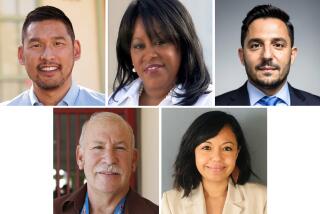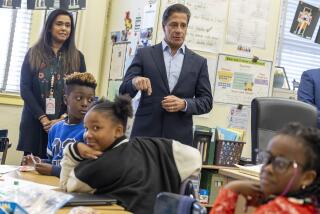Year-Round Schools: Painful Options for Board
- Share via
Darrell Bennett had spent most of a recent evening listening to 80 disgruntled fellow parents tell the Los Angeles school board why a proposal to make more schools year-round was a bad idea, but he was still confused.
“What I don’t understand,” the Chatsworth parent said, “is that, three or four years ago, the big issue was closing schools. Now, all of a sudden, we hear the problem is crowding. What in tarnation is going on?”
Bennett would seem to have a point. Because of low enrollments, the district closed 23 schools, primarily in the West San Fernando Valley, between 1982 and 1984.
Associate Supt. Sara Coughlin, who oversees the unit handling year-round plans, acknowledges that reopening those sites would help solve the problem, but only if it were possible to “pick up those schools and put them where the kids are.” And, even then, she says, it would not be enough.
Los Angeles expects an avalanche of new students by 1991: This year, about 12,000 new pupils arrived, pushing enrollment from 579,000 to 590,000. An additional 70,000 pupils are anticipated over the next four years, an amount equivalent to adding a school district the size of Long Beach to Los Angeles. The district, unable to build schools rapidly enough to keep pace with the demand, crammed campuses with portable classrooms, put 93 campuses on a year-round schedule and bused thousands of youngsters.
With no relief in sight next year, the board is faced with painful decisions. Should the district place more schools on year-round operation, a move that will inconvenience some families and probably cause many students to endure hot classrooms in the summer? Should it change the integration ratios at certain schools to make room for more minority children from crowded areas? How many millions of dollars should it spend on expensive portable classrooms that are ugly and take away playground space? And how many more students should it send on long bus rides from overcrowded schools to campuses with more room?
Staff advisers have presented the board with five plans offering various combinations of the available options. On Dec. 1, the board will give final approval to a program that it hopes will carry the district through the next school year.
The plans range from placing as many as 78 more schools on year-round calendars starting next July to adding no more schools to the year-round list next year. Year-round school is the most controversial of the proposed solutions, although all five plans also feature various combinations of portable classrooms, busing and ethnic ratio changes.
Board members disagree on the solutions. Larry Gonzalez, who represents the Eastside and has been a strong advocate of year-round schooling, said recently that delaying additional year-round schools for another year “does have merit” because many parents have complained that they have not had sufficient time to prepare for the change.
But other members say they see no wisdom in postponing “the inevitable.”
“Barring any unforeseen changes, we are moving toward a year-round school program for the (entire) district,” said Jackie Goldberg, whose region includes the densely packed schools along the Wilshire Corridor. “Avoiding year-round for one more year would be, in the short run, really politically enjoyable. . . . But I’m not willing to do that, even if it makes me very unpopular, because those same people who oppose year-round now would have every right to come back to us later and say, ‘Why did you do the politically expedient thing instead of doing what’s better in the long run?’ ”
Although proponents of year-round schooling say it has educational advantages, the district has turned to it primarily as a way to relieve crowded classroom conditions. The majority of year-round schools are concentrated in Latino and Asian neighborhoods along the Wilshire Corridor, in the eastern San Fernando Valley, downtown and in the district’s southeast quarter, where a new baby boom and immigration have sent enrollments soaring. This year, for the first time since the year-round program started in 1974, the district has proposed expanding it into schools that still have plenty of room to spare. Many of those schools are in predominantly white neighborhoods in the Westside and the West Valley.
Parents from those schools have turned out in force at two public hearings. A major complaint was that children from the same families may wind up on different year-round schedules or “tracks.”
“There is no way that I am going to have three children in the city school system who are in three different tracks in three different schools,” said Alan Rivlin, a parent from Castlebay Lane School in Northridge. “I don’t care if I have to have private tutors. I’ll pull my children out.”
Another parent complained that year-round schooling would wreak havoc on carefully planned child care arrangements.
“How will we take care of our children when they are on vacation at different times?” asked Franklin Avenue School parent Michael Ford. “We don’t need to create more latchkey children. . . . We will be forced to put our children in private school.”
Others have vigorously protested that the lack of air conditioning would turn many schools into “sweatboxes,” particularly in the Valley, where the temperature indoors often exceeds 100 degrees. Most year-round schools are not completely air-conditioned, despite the district’s longstanding pledge that they all would be.
A group of Valley parents is organizing a citywide initiative drive to ban year-round schools.
District staff members have recommended two calendars that all year-round schools would use beginning next July. The schedule suggested for elementary schools, known as a 60/20 calendar, would divide the academic year into three 60-day terms separated by three 20-day vacations. For junior and senior high schools, the staff proposed a quarter system of three 12-week terms, followed by one 12-week vacation.
Currently, five different year-round schedules are being used in the district. By reducing the number of calendars to the two proposed, the staff report concluded, families with children in elementary and secondary grades would benefit because they would have at lease one month of common vacation time. But it would take extra effort by school officials to make sure that occurs, the report said.
District officials say many factors are weighed when considering a school for year-round conversion, the leading factor being crowding. The system increases the capacity of a school by as much as 50% by allowing year-round use of facilities. That is made possible by splitting a student body into three or four groups or “tracks” that use the campus in staggered terms, with some students in school during the summer months. Students still receive about three months of vacation, although not consecutively.
About half of the schools proposed for year-round operation next year have seats to spare, however. Those extra seats may disappear at some schools over the next few years because of expected growth in enrollment. Where this occurs, district officials say, the schools will have to convert to year-round operation.
Meanwhile, the extra seats can be used by students from crowded schools. Castlebay Lane in Northridge is one such school that, according to Coughlin, has the added attraction of being completely air-conditioned.
The major reason for placing under-enrolled schools on year-round, however, is the need to accommodate overflow students from current year-round schools that have run out of space. “It is logical to look at this space,” Coughlin said.
The district calls campuses with extra room “receiving schools.” About two-thirds are located in the West San Fernando Valley and on the Westside, where there currently are no year-round schools.
Westwood Elementary, in Westwood, is an example of a school designated to be a receiver. It has 470 students and about 150 empty seats. If it ran year-round, however, it could serve 800 students, according to district calculations. It could also mean shorter bus rides for some children, Coughlin added. Schools in the Wilshire Corridor area, for example, currently send overflow students to the Valley and the Harbor area, but because Westwood is closer it would be a better match.
Ethnic composition is another factor the district considers in deciding which schools become receivers, Coughlin noted. Westwood, for example, has a substantial white population. Most of the 22,000 children the district buses because of overcrowding are minority, however, and, according to a district survey, 67% of the parents of bused students prefer to have their children attend integrated schools.
The district is concerned about running out of space at schools classified as integrated, however. In the past, the district defined an integrated school as one with up to 60% minority youngsters. But earlier this year, the board agreed to revise the definition to permit up to 70% minority enrollment at selected receiving schools. Twenty-three schools, mostly on the Westside and in the West Valley, have been proposed for the change.
District officials say the change will help reduce the long bus rides many minority children take each day to school. The 60% rule had resulted in many minority youngsters’ being bused past nearby “segregated” inner-city schools to distant campuses with at least 40% white children.
The ethnic ratio change has upset many parents, however.
Westwood School parent Linda Cotterman told the board at a recent hearing that her school lost droves of neighborhood students during the mandatory busing era but has gradually regained enrollment through strong parent participation. Now the school, with 470 students, is 58% white. But if her school is changed to year-round, and if the 70/30 integration rule is imposed, “conservatively, we’ll lose 25% of that white enrollment. . . . A lot of them are going to leave,” she said. Consequently, the number of integrated spaces that the district says it needs will be diminished. “We won’t be able to increase the capacity of our school if we don’t keep the Anglo enrollment,” she said.
Joseph Duff, an attorney representing the National Assn. for the Advancement of Colored People in its desegregation lawsuit against the district, said the NAACP supports the integration rule change, as well as the year-round concept. But he said he is concerned that the board will yield to pressure from white parents to stall the expansion of year-round schools into their neighborhoods. If that occurs, he said, it may strengthen the NAACP’s case against the district.
“If white communities don’t have to bus or receive or go on year-round, then . . . who is getting the short end of the stick?”
Few people spoke up for year-round school at the recent hearings. But year-round school officials say that their parents basically like the system, although adjustment took a couple of years.
At Oxnard Street School in North Hollywood, which went on a 60/20 year-round schedule in 1983, several parents said in interviews that if they were given a choice to return to a traditional schedule, they would choose to stay with the present system. One reason, they said, is that the system has proven to be educationally sound, as evidenced by rising test scores.
In addition, they say that both working and stay-at-home parents have found child care easier on the 60/20 calendar than on a traditional schedule. Local child care centers agreed to take children for a month at a time, and mothers who stay home have found that it is easier to keep children occupied during the shorter breaks, they noted.
Moreover, the parents said that, with children on vacation during November or March, they have the advantage of avoiding summer crowds at popular vacation spots.
“In the beginning, I was really against year-round,” said Tere Sanchez, who has two children attending Oxnard. “I thought I was going to have to quit working. I said, ‘No way.’ Then I saw the results. Now I love it.”
More to Read
Sign up for Essential California
The most important California stories and recommendations in your inbox every morning.
You may occasionally receive promotional content from the Los Angeles Times.














